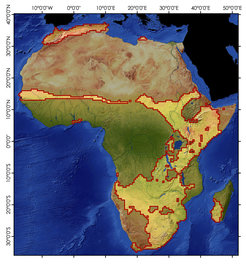Enduring Centers of Human Habitation in Africa Identified
New study identifies regions best suited to persistent human occupation through the last glacial cycle

Africa is presently the only continent where Homo sapiens clearly persisted throughout the climatic extremes of the last interglacial-glacial cycle, which lasted from about 130 to 10 thousand years ago. At different points within this timeframe, human populations inhabited a wide variety of ecologies and landscapes, such as arid savannahs, tropical woodlands, coastlines and mountainous terrain. Examining the environments in which human populations were able to survive throughout the last interglacial-glacial cycle is an important step to understanding humankind’s ability to adapt to the diversity of African habitats and explaining the expansion of our species across the globe.
Glacial cycles cause substantial climate changes that can affect the ability of a species to inhabit a particular location. For example, decreases in rainfall can lead to the expansion of deserts into savannah landscapes, turning grassland into a place inhospitable to human populations. On the other hand, some regions remain persistently habitable to a species throughout an interglacial-glacial cycle. Scientists identify such regions, called refugia, by identifying the actual distribution of a population during the most extreme climate experienced.
Our understanding of the distribution of past populations is guided by evidence in the archaeological or fossil record. Yet, these records can be fragmentary and archaeological and fossil evidence can become concentrated in areas where conditions are best for preservation, rather than representing the entire distribution of past populations. For example, cave sites can offer ideal repositories for both archaeological and fossil evidence and are readily identifiable targets. In contrast, tropical forests, where research conditions are more difficult and preservation is less likely, have typically been overlooked in the study of early human environments, but they are viewed as increasingly important to understand human evolution.

A new study led by the Pan-African Evolution research group at Max Planck Institute for the Science of Human History and the University of Liverpool has combined climatic and anthropological records to identify African refugia for Homo sapiens over the past 130,000 years.
"We've used anthropological datasets to help understand the potential climate constraints for refugia of Pleistocene populations, focusing on annual rainfall” says Dr Jimbob Blinkhorn, lead author of the paper. "We looked at the distribution of landscapes inhabited by mobile hunter-gatherers in the present and recent past to help inform models for potential distribution of much older, Pleistocene, populations”. In the study, two possible refugia models are proposed, with a conservative, narrow refugia, relating to 66% of climatic variability associated with modern populations, and a less conservative broad refugia, relating to 95% of this variability.
"Our more conservative estimate suggests up to 27.5% of the continent would have been habitable throughout the last glacial cycle, including traditional foci of research, such as the Mahgreb in northern Africa, the Rift Valley in eastern Africa, and the Cape region of southern Africa," says Dr. Matt Grove of the University of Liverpool, co-author of the study. "But we also identify the importance of southern central Africa as well as the presence of potential refugia in western Africa. Our broader refugia model is much more expansive, and includes large areas of central and western Africa that today are covered in tropical forests," adds Grove.

Dry grasslands and shrublands are the most common habitats found within the refugia identified in the study, highlighting their enduring importance for understanding human behavioural and ecological adaptation during the Late Pleistocene. However, the results of the analysis highlight that refugia for human populations often encompass ecotones - areas in which two different habitats meet.
"While more open landscapes may have been key centres for human habitation, our results highlight the importance of a diversity of ecologies, and particularly the proximity to forests," explains Prof Eleanor Scerri, co-author of the study and leader of the ‘Lise Meitner’ Pan-African Evolution research group.
To test their models, the team examined changing patterns of inhabitation of eastern Africa identified from the archaeological record.
"We found that Late Pleistocene archaeological evidence for human habitation of eastern Africa was found almost entirely within the narrow refugia, supporting our more conservative model," says Lucy Timbrell of the University of Liverpool, co-author of the study. "We noted distinct geographic patterns, suggesting that there has been continuous occupation of the Kenyan and Tanzanian Rift and adjacent regions throughout the Late Pleistocene. Significant breaks in habitation in the northern Rift valley appear in the archaeological record, that do not support the region as a potential refugia for Late Pleistocene human populations, likely indicating the impact the region’s high altitude may pose to human occupation."
This initial test supports the use of narrow refugia as a possible model for enduring occupation across the continent through the Late Pleistocene, and the team plan to further refine this with broader archaeological datasets and additional features of palaeoclimates. Yet this study outlines that human refugia for the Late Pleistocene may be more diverse than previously thought - in terms of both ecological diversity and geographical distribution.


